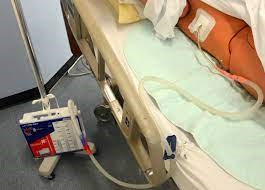A nurse is assisting with the care of a client who has a chest tube.
Which of the following actions should the nurse take?
Strip the client’s chest tube every 2 hours.
Loop the tubing of the chest tube on the client’s bed.
Place the chest tube drainage system above the level of the client’s heart.
Tape the connections on the client’s chest tube.
The Correct Answer is D
Choice A rationale:
Stripping the client’s chest tube every 2 hours is not recommended. Stripping can create high negative pressures in the tube that can cause damage to the lung tissue. It can also lead to increased pain for the patient and is generally not a standard practice in chest tube management.
Choice B rationale:
Looping the tubing of the chest tube on the client’s bed is not a recommended practice. The chest tube should be free of loops or kinks to allow for proper drainage of air and fluid from the pleural space. Any loops or kinks in the tube can lead to accumulation of fluid or air, which can cause complications such as tension pneumothorax.
The chest tube drainage system should not be placed above the level of the client’s heart. This can lead to the backflow of blood or fluid into the pleural space, which can cause complications such as hemothorax or pleural effusion. The drainage system should always be kept below the level of the client’s chest to allow for gravity-assisted drainage.
Choice D rationale:
Taping the connections on the client’s chest tube is a recommended practice. This is done to secure the connections and prevent accidental disconnection or dislodgement of the tube. An accidental disconnection or dislodgement can lead to complications such as pneumothorax or hemothorax. Therefore, all connections should be securely taped to prevent any accidental disconnections.

Nursing Test Bank
Naxlex Comprehensive Predictor Exams
Related Questions
Correct Answer is C
Explanation
Choice A rationale:
Hypertension is not typically a sign of hypokalemia. Hypokalemia, or low potassium levels, can cause symptoms like fatigue, muscle weakness, digestive problems, and frequent urination. Hypertension, or high blood pressure, is not commonly associated with hypokalemia.
Choice B rationale:
Cerebral edema, or swelling in the brain, is not a common symptom of hypokalemia. Hypokalemia is more likely to cause symptoms related to muscle function and digestion, as potassium is an essential mineral that helps regulate muscle contractions, maintain healthy nerve function, and regulate fluid balance.
Choice C rationale:
Muscle weakness is a common symptom of hypokalemia. Potassium helps regulate muscle contractions. When blood potassium levels are low, your muscles produce weaker contractions. This can result in symptoms like muscle weakness and fatigue.
Choice D rationale:
Hyperactive bowel sounds are not typically associated with hypokalemia. Hypokalemia can cause digestive problems, but these are more likely to be issues like constipation rather than increased bowel sounds.
Correct Answer is B
Explanation
Choice A rationale:
Requesting a prescription for a stool softener from the provider could be a potential solution, but it’s not the first step. Medications should be considered when lifestyle modifications and dietary changes are not effective.
Choice B rationale:
Incorporating more fluids and fiber into the patient’s diet is the most appropriate action. Constipation in older adults can be caused by dehydration and not eating enough. Dietary fiber adds bulk to the diet and is capable of absorbing water, which helps to soften the stool and promote regular bowel movements. Therefore, increasing fluid and fiber intake is often the first step in managing constipation.
Choice C rationale:
Encouraging the patient to engage in active range-of-motion exercises might not directly alleviate constipation. While physical activity is generally beneficial for overall health, increased exercise does not improve symptoms of constipation in nursing home residents or older adults.
Choice D rationale:
Advising the patient to avoid foods that cause gas might help if the patient has bloating or gas, but it won’t necessarily address the issue of constipation. The focus should be on increasing fiber and fluid intake.
Whether you are a student looking to ace your exams or a practicing nurse seeking to enhance your expertise , our nursing education contents will empower you with the confidence and competence to make a difference in the lives of patients and become a respected leader in the healthcare field.
Visit Naxlex, invest in your future and unlock endless possibilities with our unparalleled nursing education contents today
Report Wrong Answer on the Current Question
Do you disagree with the answer? If yes, what is your expected answer? Explain.
Kindly be descriptive with the issue you are facing.
